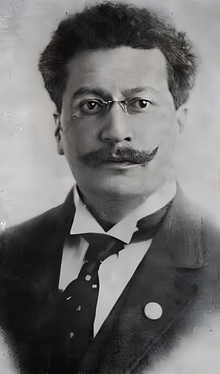Ricardo Flores Magón

Ricardo Flores Magón (born September 16, 1874 in San Antonio Eloxochitlán in the Mexican state of Oaxaca ; † November 22, 1922 in Leavenworth Federal Prison in the US state of Kansas ) was a journalist, trade unionist and writer a leading anarchist theorist and activist who supported the revolutionary radically influenced the Mexican movement . Magón was the founder of the Partido Liberal Mexicano and a member of the Industrial Workers of the World .
Political biography
Journalistically and politically, he and his brother fought very uncompromisingly against the dictatorship of Porfirio Diaz . Philosophically and politically oriented towards radical anarchist ideals and the experiences of his indigenous ancestors in the joint cultivation of the common land, he made the demand “Land and Freedom” ( Tierra y Libertad ) popular. Francisco Villa and Emiliano Zapata in particular took up the demand for land and freedom. His philosophy had a great influence on the farm workers . In 1904 he fled to the USA and in 1906 founded the Partido Liberal Mexicano. In exile he learned a. a. Know Emma Goldman . He spent most of his life in prisons and in exile and was sentenced to twenty years in prison in the US in 1918 for "obstructing the war effort." There are three different theories about his death. Officially, he died of heart failure. Librado Rivera , who saw the body with his own eyes, believes that Magón was strangled by a fellow prisoner. The state union newspaper CROM published an article in 1923 after Magón was killed by a prison guard.

Magón's ideas of libertarian socialism
Magón devised a collective anarchism based on indigenous traditions that included the thinking of early anarchists. In addition to Michail Bakunin and Pierre-Joseph Proudhon as well as Elisée Reclus , Charles Malato , Errico Malatesta , Anselmo Lorenzo , Emma Goldman , Fernando Tarrida del Mármol and Max Stirner , his thinking shows great parallels to Peter Kropotkin . Flores Magón also studied the writings of Karl Marx and Henrik Ibsen .
Magonista's importance today
In addition to the Zapatista movement in Chiapas , the “Indigenous People's Council of Oaxaca - Ricardo Flores Magón” CIPO-RFM and the “Union of Indigenous Communities of the Northern Zone of the Isthmus” UCIZONI refer to Magonist thinking today.
“He was one of the founding fathers of the Liberal Mexican Party and developed into a leading theoretician and propagandist of collective anarchism. Unlike Zapata, Magón was not suitable for manorial adaptation. He incorporated the experience of indigenous collective structures into his conception of libertarian socialism. Magón saw himself as an anti-imperialist and an internationalist at the same time, his supporters, the Magonistas, coined the slogan »Tierra y Libertad«, which was only later taken up by the Zapatista movement and which today sums up the program of mostly indigenous farm workers , young world
Fonts
- Ricardo Flores Magón: Tierra y Libertad . Selected texts. ( Classic of the social revolt, vol. 11) Münster: Unrast 2005 ISBN 3897719088
- Ricardo Flores Magón, Chaz Bufe and Mitchell Cowen Verter (eds.): Dreams of Freedom: A Ricardo Flores Magón Reader . AK Press , Stirling 2005, ISBN 9781904859246 .
Secondary literature
- Ward S. Albro: Always a Rebel: Ricardo Flores Magón and the Mexican Revolution . Texas Christian University Press, 1992, ISBN 9780875652818 .
- Colin MacLachlan: Anarchism and the Mexican Revolution: The Political Trials of Ricardo Flores Magón in the United States . University of California Press, 1991, ISBN 9780520071179 .
- John M. Hart: Anarchism and the Mexican Working Class, 1860-1931 . University of Texas Press, 1987, ISBN 9780292704008 .
- James D. Cockcroft: Mexico's Revolution Then and Now . Monthly Review Press, 2010, ISBN 9781583672242 .
Web links
- Literature by and about Ricardo Flores Magón in the catalog of the German National Library
- El Magonismo en la memoria
- Magonismo y resistencia indígena en México
- Pequeña biografía de Flores Magón en el Sitio Campesino
- Short biography and reviews of works by Ricardo Flores Magón at perlentaucher.de
- Brief information of the CIPO-RFM [1] (German)
- The "Progetto Flores Magon" of the Unione Sindacale Italiana (USI-AIT) in Chiapas / Mexico [2]
| personal data | |
|---|---|
| SURNAME | Magón, Ricardo Flores |
| BRIEF DESCRIPTION | Mexican revolutionary |
| DATE OF BIRTH | September 16, 1874 |
| PLACE OF BIRTH | San Antonio Eloxochitlán, Teotilán del Camino , Mexico |
| DATE OF DEATH | November 22, 1922 |
| Place of death | Leavenworth (Kansas) , USA |
